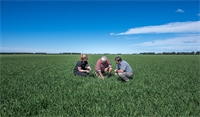Pasture renewal: a key investment for farm productivity
Renewing pastures is one of the most impactful steps farmers can take to improve productivity, livestock performance, and overall farm profitability. By replacing tired, underperforming paddocks with modern, high-yielding varieties, you can lift dry matter production, boost animal health, and get more from every hectare. With good planning and execution, pasture renewal offers strong returns that far outweigh the upfront investment.
Why renew pastures?
Over time, pastures naturally decline due to pressures like overgrazing, weed and pest invasion, drought, poor drainage, and depleted soil fertility. This leads to a loss of desirable species and an increase in less productive or unproductive plants. The result? Reduced dry matter yield, lower metabolisable energy (ME), and poorer outcomes for livestock.
Renewal is an opportunity to reset the paddock, correct underlying issues, and re-establish a productive, healthy sward. It's a valuable tool for all grazing-based systems, not just high-input operations, to unlock better performance and profitability.
Six key steps in pasture renewal
-
Identify underperforming paddocks: Start by selecting the paddocks delivering the lowest returns. Use grazing records, pasture scoring, and visual checks to assess paddock condition. Look for low dry matter yields, poor persistence, weed dominance, or limited grazing cycles.
-
Diagnose the causes: Understanding why a paddock is underperforming is critical to choosing the right renewal approach. Check for common culprits like nutrient deficiencies (via soil testing), poor pH, compaction, drainage issues, or pest and weed pressure.
-
Choose a suitable renewal method: Select the renewal method based on your farm's needs and the paddock’s condition:
-
Plan ahead and prepare: Effective renewal starts months in advance – ideally 6 to 18 months before sowing. Control weeds and pests early, correct soil fertility issues, and prepare the seedbed well. Use appropriate herbicides and consider insecticide-treated seed to give young seedlings the best start.
-
Select the right species and cultivars: Choose pasture species and cultivars suited to your region, soil type, and farming system. Consider heading date, endophyte options, and mix clovers or other species as needed to build a balanced, resilient sward.
-
Manage new pastures carefully: New pastures need careful management in their first year. Avoid grazing too early or too hard – stock should be removed before damage occurs. Monitor for pests, maintain weed control, and apply fertiliser as needed to promote establishment and strong tillering.
Avoid these common mistakes
To ensure success, steer clear of these pitfalls:
Review and assessment
After establishment, assess the performance of your renewed pasture. Take note of what worked and what didn’t and use those insights to refine future renewal efforts. Good pasture management doesn’t end after sowing; it’s an ongoing cycle of improvement.
For more information or assistance with selecting the right seed types and treatments for your pasture renewal, contact your Ruralco representative.
Related

The end of November, early December has finally brought some settled sunshine across the region, wit...
Read More

For the next 2 months we are looking at the final sprays for finishing off our cereal and grass seed...
Read More

Growing forage brassica crops for summer or winter feed take planning. Insect pests can limit brassi...
Read More

November’s Agrichemical Update focuses on getting the most from your spray programme. We cover cere...
Read More

November has kicked off in true Canterbury style with a dusting of Labour weekend snow. It’s been a...
Read More

Arable growers have launched a logo to champion NZ-grown grains in bread and cereals. With most supe...
Read More